Long Weekend in Iceland
Being an Icelandic person living in the UK, lots of people always ask me about top tips for Iceland - some people want to do the ring road, others want to do long weekends in Reykjavik and travel from there, either in a rental car or by doing organised tours. This blog is to help those planning to visit Iceland on a long weekend.
TRAVELICELANDEUROPE
Thru
3/2/202530 min read
Note: Affiliate links exist within this page. However, these are based on real recommendations and clicking the links will not cause any additional cost to you but will support covering the hosting expenses of our blog.
Table of Contents
Below you can click the links to skip to a specific section of this page:
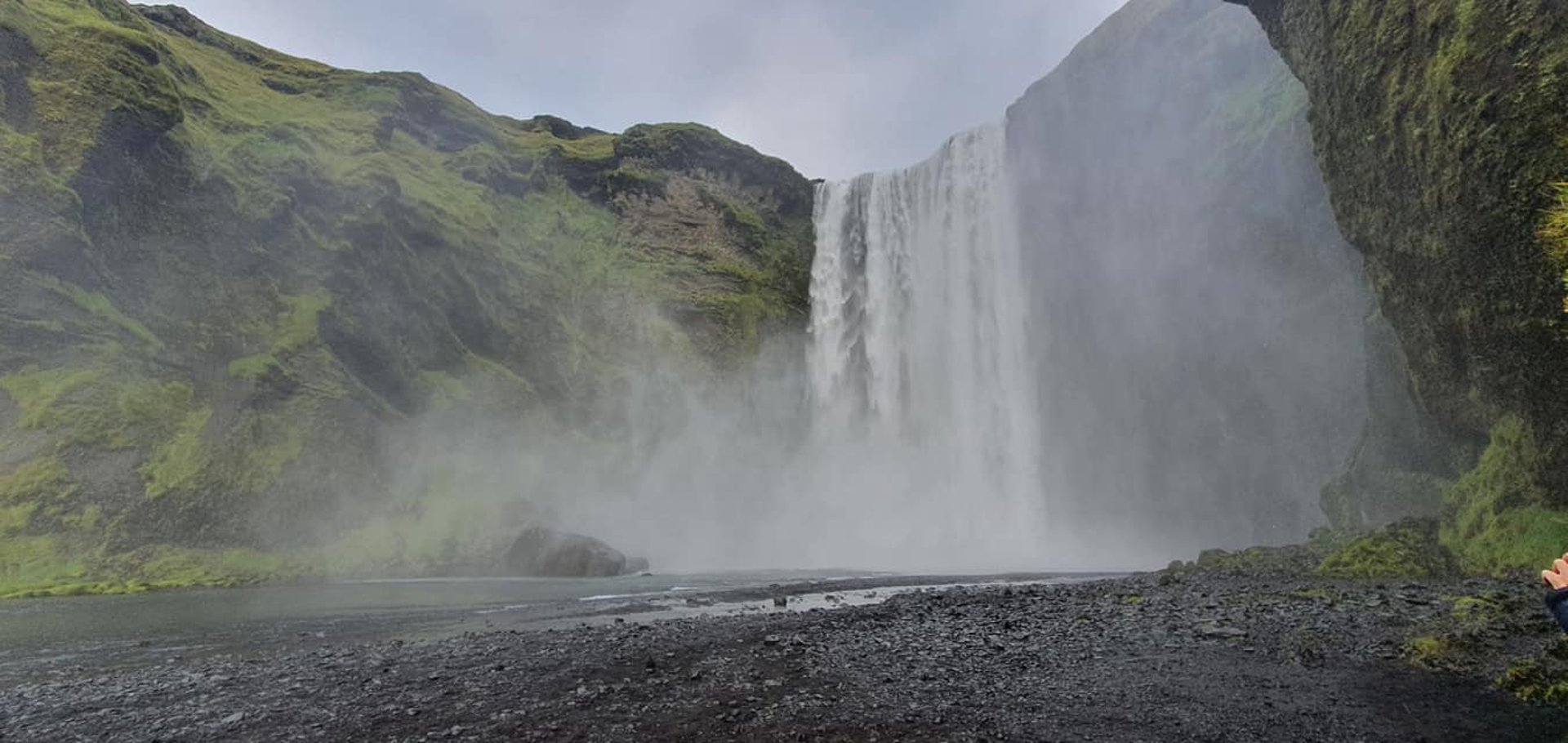
How to get to Iceland?
Getting to Iceland is generally easy. It is incredibly well connected with Europe and North America. The national airlines are Icelandair and Play the former being the more long-standing carrier, but there are dozens of other airlines that also fly direct to Iceland, and if not direct then with a connection through an airline alliance. The cheapest ones by far are WizzAir and EasyJet. We fly EasyJet from Edinburgh in 95% of instances when we go to Iceland because the price difference between EasyJet, which flies from Edinburgh, and Icelandair, that flies from Glasgow, cannot possibly be justified (often costing us £60 GBP per person for the return flight). Just be mindful that the international airport is Keflavik (KEF), some 40min west of Reykjavik, while Reykjavik airport (RKV) is just a domestic airport.
Below you can see the very many direct routes you can fly to Iceland:
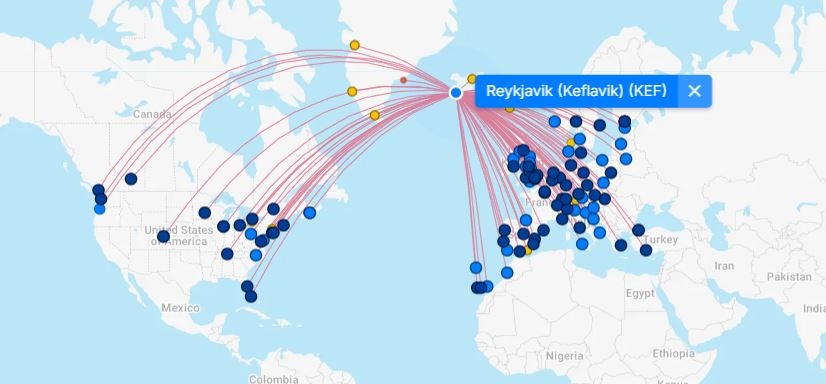

Direct flights to Iceland from USA, Canada and Europe (Image: Flightconnections.com)
But rather than clicking through lots of different airlines to find the cheapest flight from where you're going, you're probably best looking up flights on a flight search engine which will search all the airlines. If you are flexible with your holidays, you can get mega low price flight alerts for flights to Iceland (and elsewhere!) at Jack's Flight Club. They find the absolutely best deals as soon as they come up. You can literally save hundreds of pounds on flights (like I got an alert for a return flight to Cancun in Mexico for £270 the other day!! Say whaaaaaat!!?). We've been members for 2 years and all I can say is... darn... I wish I had more annual leave to take advantage of all those crazy offers! They are offering a 30 day trial for £1 GBP with money back guarantee within 14 days if you don't get to the same conclusion as me.
What time of year to visit Iceland?
As an Icelander living in the UK, this is literally THE QUESTION I get asked the most! And it's an understandable question, as your experience of Iceland will vary depending on when you go and the seasons offer very, very different experiences.
SUMMER: Most people think summer is the best time to go and I guess in many ways it is because the weather is better and the days are longer ("longer" is an understatement, the sun does not set in summer, i.e. daylight all day and all night long 24hrs/day). HOWEVER, it is also the busiest time which has a lot of disadvantages. Prices shoot up like crazy and if you ever heard somebody talking about how expensive Iceland is, they probably went during summer, cause yes, it is insanely expensive. I never, ever go home to Iceland over the summer time just cause I literally can't afford it. Because of the crowds, it also gets tricky getting rental cars, getting accommodation particularly in the countryside and at tourist attractions, getting parked can be a bit of a nightmare (again, understatement). If you are quite well off and happy to go a bit off the beaten track to avoid the Disneyland type of crowds, then you will thoroughly enjoy the summer in Iceland, because it is beautiful. The highlands, which form some of the most beautiful places in Iceland, are only open mid-summer to mid-autumn. You however will not be able to see the northern lights because it doesn't start to get dark until late August. Summer is best if you plan to do bird watching and whale watching, but late spring is also good.
AUTUMN: The autumn colours in Iceland are really beautiful and autumn is a lot more quiet compared to summer, as well as much cheaper. It also gets dark at night but still plenty of daylight during the day for exploring, so good if you're a person who cannot sleep during daylight hours (like it is 24/7 in summer). The summer weather may hold well into the autumn, so you can still travel in a campervan for example into mid- to late September and the highlands will be open for most of it. Generally the weather isn't much worse than in the summer, however it is possible to get the tail-end of tropical cyclones coming from the Caribbean which can produce some extreme storms in autumn but they are not too common. Just keep an eye on the forecast if you plan to do trekking or hiking in the wilderness or if you're planning to drive along a road known for sand storms (particularly bad in strong winds along the Road 1 edge of Vatnajokull glacier as well as along Road 1 in the desert of the northeast as you travel between Egilsstadir and Myvatn). As it gets dark, you get to see the northern lights, which are actually quite common around the autumn equinox, as long as you get clear days.
WINTER: I must say, the winter in Iceland is ROUGH. It is cold, it is extremely dark and because of that, you'll have almost no daylight to explore the many natural wonders of Iceland. We're talking 4hrs of daylight between midday and 4pm in the south of Iceland and in places like Ísafjörður in the Westfjords of Iceland, they don't see the sun rise above the horizon for a full month! It is definitely not for everybody. It is also not safe for most travellers to drive a rental car in Iceland, or at least I'd certainly not recommend it to those not used to winter driving, because that, too, can be incredibly rough and scary, even for an Icelander. Organised tours are the way to go. On the plus side, if you like the idea of seeing frozen waterfalls that can be arranged in winter, as well as more hours of darkness with a chance to see the northern lights. It is also a cheap time to visit compared to summer or autumn, as December and January are the low season with the least number of visitors and businesses will be very keen to get your business. If you do decide to go to Iceland during the middle of winter, DEFINITELY consider buying anti-slip spikes for your shoes, as the local councils do a terribly bad job at de-icing pedestrian pavements. Also, if you DO brave it to self-drive in Iceland during winter, be sure to ask for tyres with spikes aas well, called "Nagladekk" in Icelandic (literal translation: "Nail tyres"). The best thing to do on a dark winter afternoon in Iceland is to go to geothermal pools, either touristy ones or pubic ones (called "Sundlaug"), which are cheaper but also geothermally heated, enjoy good food, read a good book and/or wait for the northern lights to show. What surprises many people is that snow is actually not all that common in Iceland during winter, but if you want to see snow your best chance is definitely in winter.
SPRING: The spring is a cheap time to go to Iceland, as winter is, but much more daylight. However, there's still enough night time darkness to see the northern lights, at least until May. Everything is slowly starting to come to life but vegetation remains very "beige". If you want to see puffins and other birds, as well as go whale watching, late spring can be a good time to go without paying over the odds, as you would in summer. The highlands are closed at this time of year because the snow is melting and the roads are messy. We often end up going in spring because the flights with EasyJet are super cheap (like £60 quite often for return flight), the car rental is cheap (you can easily get a car for £40 GBP/day) and the hotels are reasonably priced too - the trick with the hotels a lot of the time is to book last minute, like 1-3 days before you go, because the price can easily drop dramatically. However, you do risk not necessarily getting your first choice, which may have sold out. But we've done this many, many times and always been successful at snatching a bargain on comparison pages like Booking.com (25% discount is not uncommon). Weatherwise, it can be very much a hit or a miss in spring - winter can linger, or summer can come early. Therefore you need to keep an eye on the weather forecast.
So what season do I recommend? My personal favourite is the autumn, so typically September and October, primarily due to it being cheaper and quieter compared to summer. Spring is the same but the benefit of autumn over spring is the autumn colours, which are just honestly gorgeous. Meanwhile, the vegetation is different hues of brown and yellow in the spring. I tend to avoid winter and summer.
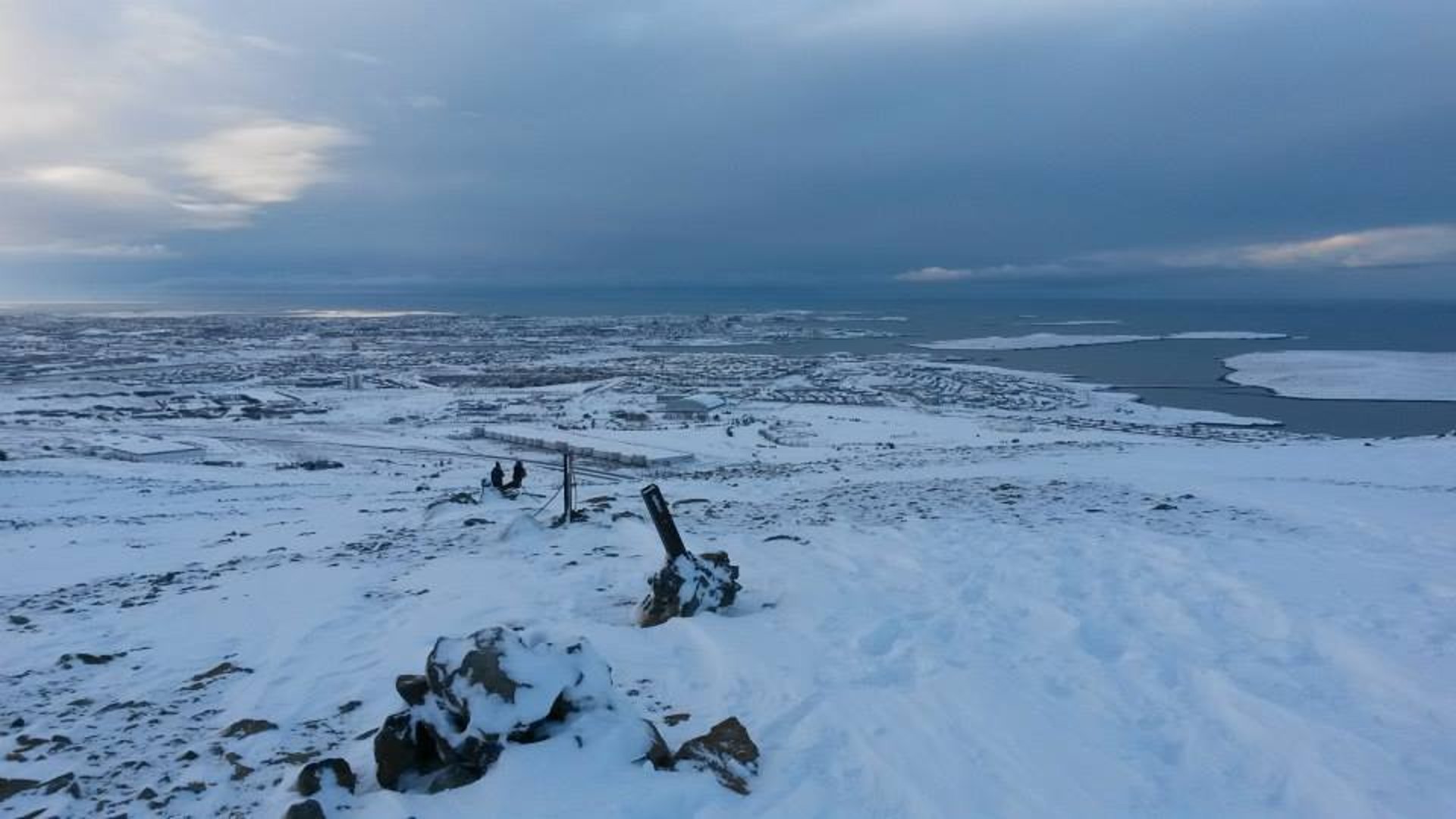
How to get around Iceland?
How to get around Iceland depends on what time of year you go. However, be warned that public transport in Iceland, particularly outside of Reykjavik, is both incredibly expensive and pretty useless to be honest. The local bus company in Reykjavik is called Strætó and they have a wide network of regular departures across the whole metropolitan area.
Literally the only reason to use public transport outside of Reykjavik, in my view, is to get into the highlands as you otherwise need a 4x4 vehicle. Particularly if going to Þórsmörk National Park, which requires some serious skills at navigating through murky turbulent glacial rivers (no bridge!) with strong current and rocky riverbed. So if you don't drive, the way to go is with daytours that take you to all the wonderful places you want to see in Iceland.
Ify you are hiring a car I would just say though is that make sure you go with a reputable company (check their ratings on Google or whichever rental car comparison you decide to use). Some of the Icelandic agencies are dubious at best.... I would also recommend getting a car hire excess insurance. If you're in the UK like we are, we have used ReduceMyExcess numerous times in different countries, where on one occasion I scraped the front bumper of the car on an exceptionally high speedbump in Reykjavik, and fortunately for me, the excess insurance paid out quickly. So from personal experience, I'd recommend ReduceMyExcess.
If you don't fancy daytours, then the way to go is to rent a car and go driving yourself. It's generally pretty safe as long as you got your wits about you for potholes, sheep and impatient Icelanders constantly overtaking. Weather can also be a factor most seasons of the year but generally managable except perhaps in the height of winter, when I don't like driving personally. Speed limit is 90 km/h on main roads and there's quite a few speedcameras dotted around.
Note that if you are driving, it is very useful to have the Parka App [Android / iOS], which you can set up with your rental car's registration number and pay for parking in Reykjavik and beyond. Most places accept payment for parking through this app, with a few exceptions. When parking in Reykjavik, it's timed parking so you have to first activate your parking, then unactivate it when you leave and it will charge you as per time spent in the car park. For tourist destinations, it's generally flat fee for the day.
Day 1: Arrive in Reykjavik
Getting there
The international airport in Iceland is actually not located in Reykjavik, the capital, but in Keflavik some 45km west of the capital. There are three primary ways to get from Keflavik airport to Reykjavik.
By taxi. The taxis are located directly outside the terminal on the arrival side of the terminal. It is a good idea to ask about the price before setting off. All cars accept credit cards. Taxis are very, VERY expensive in Iceland and I'd avoid taking them unless you're a large group of people (or if you're rich!). You can also organise a private transfer beforehand which may set you back about £120 GBP per group of 3-4 people. There is no Uber or similar in Iceland.
By rental car. Rental cars in Iceland are usually pretty cheap except at the height of summer. Paying £40-60 GBP per day is not uncommon. You will need to consider where you're going to park though, but with the help of the Parka app, you can see where you are allowed to park overnight without paying (there won't be a parking zone), or how much you'll have to pay for parking if you keep the car there.
By an airport shuttle. This is the best way if you're not comfortable driving and there's not enough of you to share a taxi. There are several companies, like Reykjavik Excursions which is the company me and Joe used to work for when I was finishing university and Joe took a career break. They are a long-running well established company in Iceland. There are several others which are much of a muchness in terms of services and prices, which tend to be in the £22 per person range.
Where to stay
On arrival in Iceland, you'll likely want to check into your hotel and find your feet in Reykjavik on your first day. While the Reykjavik metropolitan area spreads over a fairly large area, the city of Reykjavik is much smaller and the city centre even smaller, so it can easily be explored on foot (unless you have mobility issues).
We travel to Reykjavik pretty frequently, at least once a year sometimes twice. Therefore, when choosing a hotel / an apartment / an Airbnb, you'll want to stay in the city centre where you'll find most of the restaurants and places of interest to tourists. We have stayed in a fair few places around town and definitely have our favourite places by this point, though quality of accommodation varies as the years pass.
For example, we have always loved staying in the Reykjavik Residence Hotel which has studio flats all across the core of the city centre, all of which are incredibly conveniently located. While the hotel is still good (and recommended), we have been disappointed by the standards creeping down over the years. We used to get the most AMAZING breakfast included in the hotel price, but now they charge extra for it (and it is a lot of money extra too!). The newer rooms are also substantially smaller than what they used to be. But still good quality for the money, in our opinion. However one thing to note is that many of their flats are either on basement levels or ground level smack in the middle of the action, and the core of Reykjavik city centre can get pretty noisy with party people on Friday and Saturday nights. So perhaps packing a part of air plugs would be an idea if you're not the type to join in on the street party that may well last until 7am. The hotel has no parking.
Another place we absolutely love is Sif Apartments. It's located near Hlemmur local bus station but it's far enough away from the core of the city centre so it's usually pretty nice and quiet. We love it cause their flats are huge and have all modern comforts. It does tend to be quite a lot pricier than Reykjavik Residence a lot of the time but sometimes you can strike a bargain and when we do, we jump at it, because we know it's a great place to stay.
The third place we quite like is the Hilton Nordica. It is located a little bit further away from town compared to Sif Apartments by maybe 7 minutes walking, but the benefit is that there's a carpark, unlike many places closer to town. If you get a north-facing room it's particularly nice as you get a lovely view over the bay and Mt Esja in the distance, but on top of that you'll get fantastic view of the northern lights from the comfort and warmth of your room if you're there in autumn/winter/early spring (as long as you remember to turn off the lights in your room!). Another reason we like this place is that as Hilton Honours members (we get membership via our American Express Platinum card), which gives us possible room upgrade plus free breakfast, which is nice.
Places to eat and drink in Reykjavik
Contrary to popular belief, Icelandic food is actually amazing. Yes, there is rotten shark, scorched split sheep heads and sheep testicles made into a jelly in acid but this isn't really what people commonly eat in Iceland. The primary Icelandic produce is fish and lamb. There is also chicken, pork and beef to be had but to a lesser extent.
Reykjavik has some excellent restaurants but many of them are very, very expensive. To be honest, I've rarely eaten at a Reykjavik restaurant, we just have our favourites that are reasonably priced given Icelandic prices.
Sæta Svínið at Ingólfstorg Square in town centre.
This is our favourite place and we go here every single time we're in Iceland if we can help it. Everything on the menu is good but we tend to go for the slow cooked shoulder of lamb to share as it's tasty, huge and great value for money. Their waffle fries are to die for.Lebowskis Burgers on Laugarvegur
Simple. Burgers. There are lots of new places that have popped up lately which we haven't tried but Lebowskis delivers excellent burgers that are not expensive (for Iceland)Messinn on Lækjargata
The best-value fish restaurant in Reykjavik I'd say. Their trout is excellent and I imagine all their fish pans are. When we were there, their service wasn't the best from the waiting staff but the food was good.Þrír Frakkar on Baldursgata
If you're looking for something very Icelandic, this restaurant has it.Hlöllabátar on Ingólfstorg Square
Icelandic steak subs which are delicious! I always ask for the "Höfðabátur" which has sliced lamb, ham, melted cheese, crunchy onions (like those you get in hotdogs), lettuce and a mayonnaise based sauce. I always ask for additional bernaise sauce. It's incredible, especially for lunch or a late night snack after drinking. Another very popular one us the "Tuddinn" which contains bacon, sliced beef, melted cheese, lettuce, shredded cucumber and mayonnaise based sauce.Svarta Kaffið on Laugavegur
This place serves the famous hard-crust bread bowl (like, the bread is the bowl) soup. Very popular for the bread but I must say that Icelandic soups tend to be pretty underwhelming (after living in the UK for over 10 years).
There are also several high-end restaurants immensely popular like Fiskimarkaðurinn (The Fish Market) and Grillmarkaðurinn (The Grill Market). Aside from those, genuinely you're spoiled for choice. All I can recommend are the ones that we frequent when we're there.
Alcohol is expensive in Iceland - how do you save money on it?
If you are one of those that like going out for a drink (there are many of us out there!), then a popular website to have a look is the Happy Hour website. It will tell you where to get the cheapest drinks at any given time. For us personally, we'd rather pay more and get Icelandic craftbeer. The best place for that in all of Reykjavik is Skuli Craftbeer Bar in the town centre. You'll find them on Untappd but they're definitely not the cheapest.
If you'd rather have drinks while chilling in your hotel room / airbnb etc then you'd need to go to the state run alcohol store Vínbúðin. There's one in the town centre near Ingólfstorg Square. However, if you really want to save on booze, the way to go, and what EVERY Icelander who likes their drink does, is to buy your full duty free allowance as you come off your plane on arrival in Keflavik International. The duty free shop is in the same zone as baggage reclaim, so pop in while you wait for your bags to arrive. The personal allowance is shown on posters inside the shop and unlike most duty free shops around the world, the price difference of alcohol and tobacco is absolutely massive versus once outside of the airport terminal. Trust me on this.
Things to see in Reykjavik
I must be honest here - Reykjavik is not really the place people come enjoy Iceland, unless they're really into partying as Reykjavik has plenty of that on the weekends for such a small place. Don't get me wrong, it's a cute place but there's not awfully a lot to do aside from eat good food and drink good beer, most people head out of the capital to explore the natural wonders of Iceland - and there are a LOT of them!! However, on your day of arrival you'll be unlikely to be going on a daytour, so you may want to explore the capital. The places you may want to check out in the city during the day include:
The Icelandic Museum of Natural History exhibit in Perlan
This building is quite unique in Iceland, as it's a glass dome built on top of six hot water tanks and it's the second most important landmark in Reykjavik. The dome used to be a cafe and a rotating restaurant at the top but the bulding now serves as a tourist destination with a viewing platform and an exhibit of the Icelandic Museum of Natural History. It's well worth your time, albeit a bit expensive.Hallgrimskirkja church
The biggest and most famous landmark of Reykjavik if not Iceland, this church towers over the city centre. The architecture is special as its fron represents the famous basalt columns found in many places in Iceland, but if you look at the church from the side, it represents the shape of a famous mountain ridge in the north of Iceland.Sky Lagoon
I have not been here yet but I need to go!! We ran out of time the last time we were in Iceland but this place is very much on our radar. People absolutely rave about it, saying it's cooler than The Blue Lagoon. That's some big shoes to fill.The Lava Show
The famous lava show used to be solely in Vik but they've opened an outlet in Reykjavik. Personally (as an Icelander) I find it a bit cheesy but people who have visited have been really impressed and found it to be one of the highlights of their trip to Iceland, so it makes this list.Laugavegur Street
Laugavegur or "Pool road" leads from the city centre and towards the Laugardalur ("Pool Valley") in the east of the city centre. It used to be a popular shopping street for Icelanders many years ago, with fashion stores and gift shops but then the shopping centres of Kringlan and Smaralind opened and the outdoor shopping experience died a slow painful death. The street has been revived by tourism, but it now has a lot of restaurants, pubs, cafes, clubs, hotels and tourist shops. It still retains the cozy look of an old Icelandic village with colourful houses covered in corrugated metal.Harpa Concert Hall
One of the more recent landmarks, a concert hall built of glass and located at the Reykjavik seafront.The Sun Voyager sculpture by the sea
There is a pedestrian path that runs along much of the Reykjavik coastline and along this path you find the Sun Voyager sculpture which is a kind of a metallic skeleton that is meant to represent a viking ship. The backdrop is very pretty with the bay and Mt Esja, and it's a very popular place to come to see the northern lights at night during autumn/winter/early spring as there's minimal light pollution here.FlyOver Iceland
This is a sort of virtual reality experience without the VR headset but it is very convincing, making you feel like you're flying over the natural wonders of Iceland. It is incredibly popular with Icelandic people and tourists alike and I highly recommend it! We did it in Iceland last time we were there and thoroughly enjoyed it. You really need to experience it.Whale Watching
There are lots of outlets in Reykjavik doing whale watching, with Reykjavik, Hafnarfjordur and Husavik being the main places you can do these tours. If you're based in Reykjavik, it makes sense to do it from there. The best time for whale watching in Reykjavík is from April to October, with peak sightings in the summer months of June, July, and August. During this period, the waters around Iceland are rich in food, attracting a variety of whales, including humpback whales, minke whales, white-beaked dolphins, and sometimes even blue whales. While whale watching tours operate year-round, winter (November to March) can be less predictable due to rougher seas and fewer whales in the area. However, winter tours offer the chance to see the Northern Lights in the evening, making for a unique experience.Night time Aurora walks along the coastline
You can pay for a Northern Lights tour in the autumn/winter/early spring but it's not at all necessary IF there's forecast for a clear night in Reykjavik. Genuinely, you get some fantastic views of the northern lights from the coastal path along the Reykjavik Harbour, looking north towards Esja, and it's free. However, if it does look like Reykjavik could be cloudly, you might have a better chance on a tour. The cloud cover and aurora forecast can be found on the Icelandic Met Office's website. Furthermore, to save yourself from freezing outside as you wait, you can monitor the activity of the solar particles in real time using the Leirvogur Magnetic Observatory station. If the lines are completely flat, it is highly unlikely anything is happening at the present time, so keep sipping that beer indoors in the warmth! However, if that line starts to become pretty mental, then head outside and walk along the coast. The lights are elusive though and come and go, so be patient!
The above are the things I would first of all recommend you doing when staying in Reykjavik, but there are a fair few attractions for tourists in the city that might not be as high-profile. These include:
Whales of Iceland Exhibit
Educational exhibit dedicated to regional whales, with life-sized models & interactive features.Nauthólsvík Geothermal Beach
If you're in Iceland in summer and the weather is half-decent, this is a popular golden-sand beach offering a lagoon with warmed water (using the water from the Perlan tanks, see above), hot tubs, plus a snack bar. If you're into sea swimming, this is a hugely popular place with your type of crowd!Reykjavík Maritime Museum
Maritime museum in a former fish factory with historic ships & exhibits on local fishing industry.Saga Museum
Lifelike figures depict Iceland's history at this museum where visitors can put on Viking costumes.Tjörnin Pond
A lake next to the Reykjavik City Council building with lots of birds. A scenic place to go for a walk.The Settlement Exhibition
Remnants of 10th-century Viking settlements in Reykjavik are preserved in this interactive museum. Building practices were always pretty poor in Iceland so not many buildings have survived, so this is one of the oldest structures that exist in the country.National Museum of Iceland
Objects from the Settlement Age to the present, 20th-century photography & temporary exhibitions. I was here many many years ago and I'm not sure if they've updated their exhibit since then, but if you're interested in Viking artifacts, this is the place to go, along with typical popular culture items.Reykjavík Park and Zoo
If you are travelling with children this might be a nice place to visit. It is a amall zoo with a focus on Icelandic farm animals, plus children's rides such as a carousel & train. Iceland doesn't allow any exotic animals, hence why there are just Icelandic farm animals here.Árbær Open Air Museum
This is an open air museum consisting of relocated old houses, a farm & other displays tracing the history, culture & folklore of Reykjavik.The Phallological Museum
Yes, there's a museum dedicated to the world of animal penises. It's weird but some people like it.
Day 2: Daytour to the Golden Circle
If this is your first time in Iceland, chances are you were attracted to coming to Iceland because of its amazing hotsprings, waterfalls and natural wonders. The Golden Circle ticks A LOT OF BOXES for most people, if not everybody. It's a great tour to go on pretty much regardless of the weather, because the sights are very impressive. You have a bit more flexibility if you do a self-drive tour and I would recommend starting early regardless of whether you're doing self-drive or a tour. If you do the earliest tour you WILL beat the crowds and if you knew the difference between the two departures, the early and the 2 hour later one, you'd agree. I say this as I used to work as a tour guide and there was a huge difference between the 9am departure (the tour EVERYBODY takes including multiple buses with multiple companies) and the 7am departure, which tended to just be me driving a minibus with maybe 5-9 passengers and they'd have the sights largely to themselves. The early bird really does catch the work, and it is never more so true than on Cruise Ship days when the Golden Circle attractions are genuinely like Disneyland. SO. INCREDIBLY. CROWDED.
So basically my recommendation is start early. And this is even more important if you know there's a cruise ship in town.
The typical tours usually include three MAIN elements: Þingvellir National Park, Geysir and Gullfoss. Then companies / people planning their self-drive tend to pick one or two additional stops.
Þingvellir (Thingvellir) National Park is one of Iceland’s most famous natural and historical sites, located about 40 km (25 miles) northeast of Reykjavík. It is a UNESCO World Heritage Site and a key stop on Iceland’s Golden Circle route. Its main importance is associated with history and geology. It was the site of Iceland’s first parliament (Alþingi), established in 930 AD, making it one of the oldest parliaments in the world. Major historical events, including the adoption of Christianity in 1000 AD, took place here. It remained Iceland’s political center until 1798. In geological terms, it's incredibly important because it is essentially where they could prove the Theory of Plate Tectonics. It's located in a rift valley that slowly but steadily is moving apart and the lake is in fact forming one of the depressions of the rift valley. The plates are drifting apart at a rate of about 2 cm per year, creating dramatic cracks and fissures in the landscape. The Almannagjá Gorge is a visible example of this tectonic movement, which is where you walk through when you visit the park. If you had the time (and desire), you can also dive in one of the water-filled fissures.
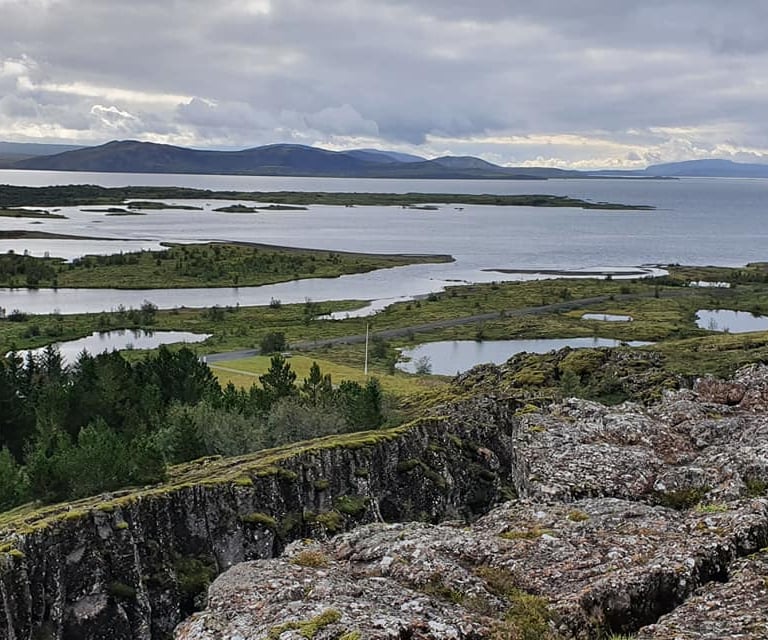
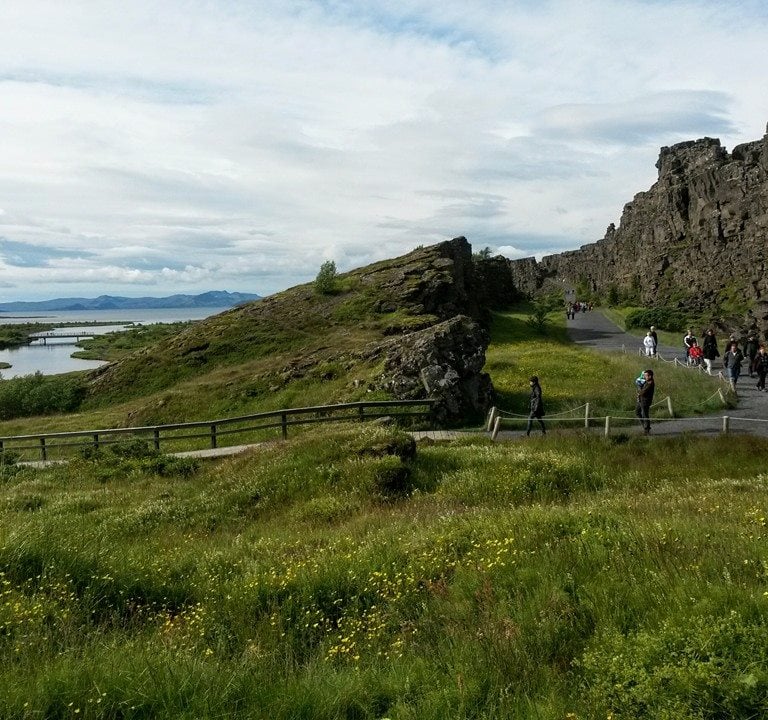
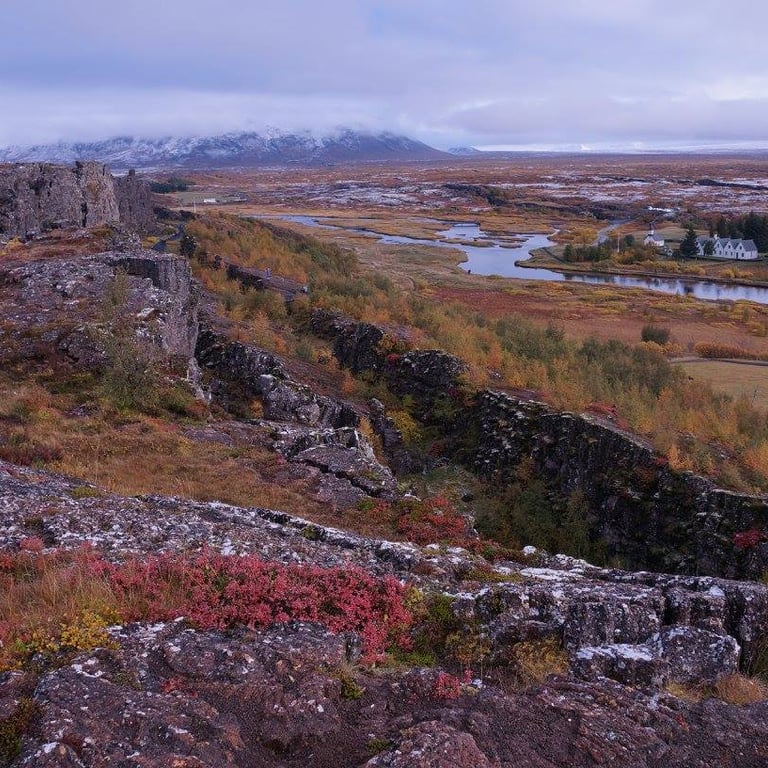
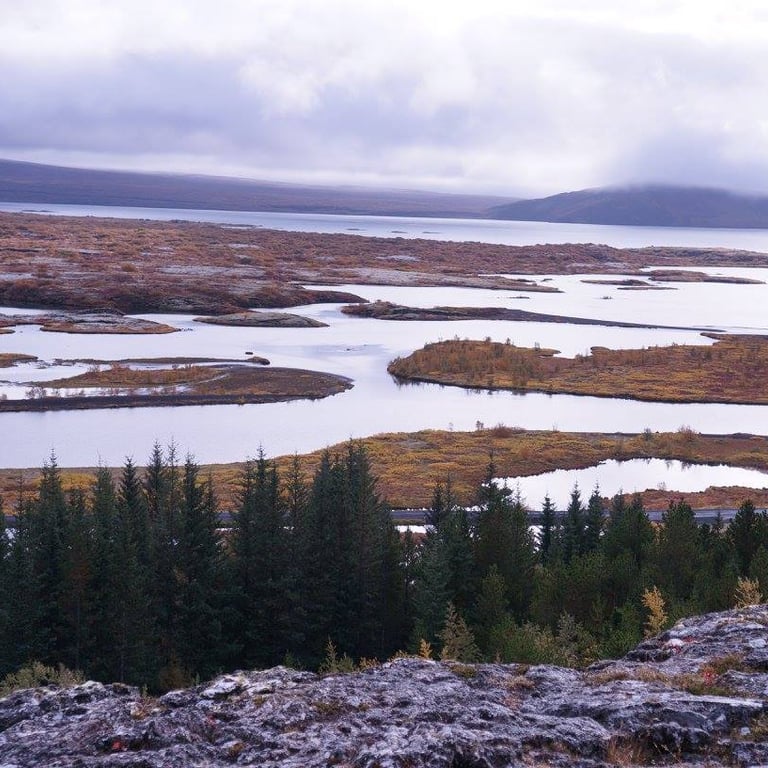
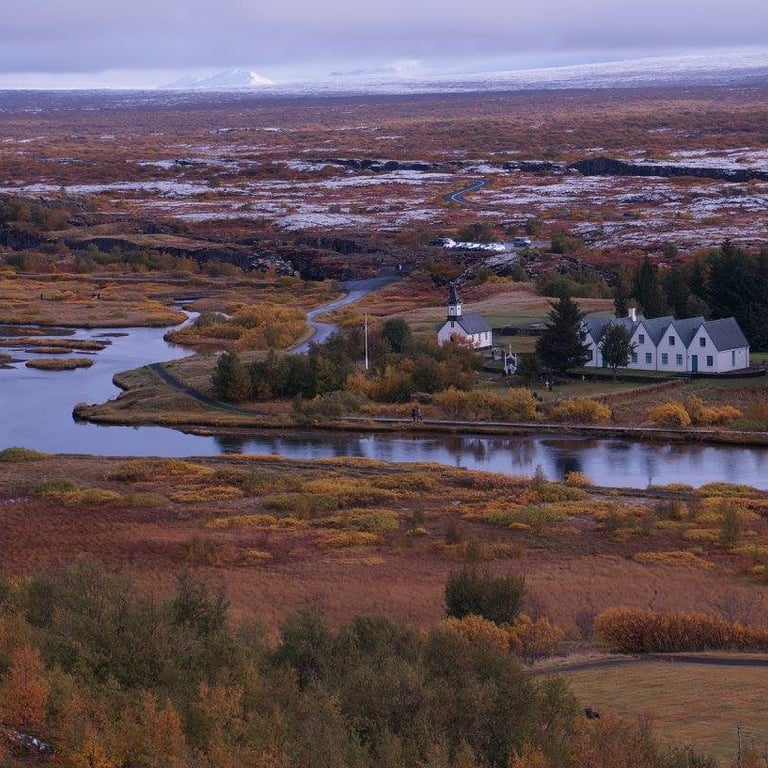
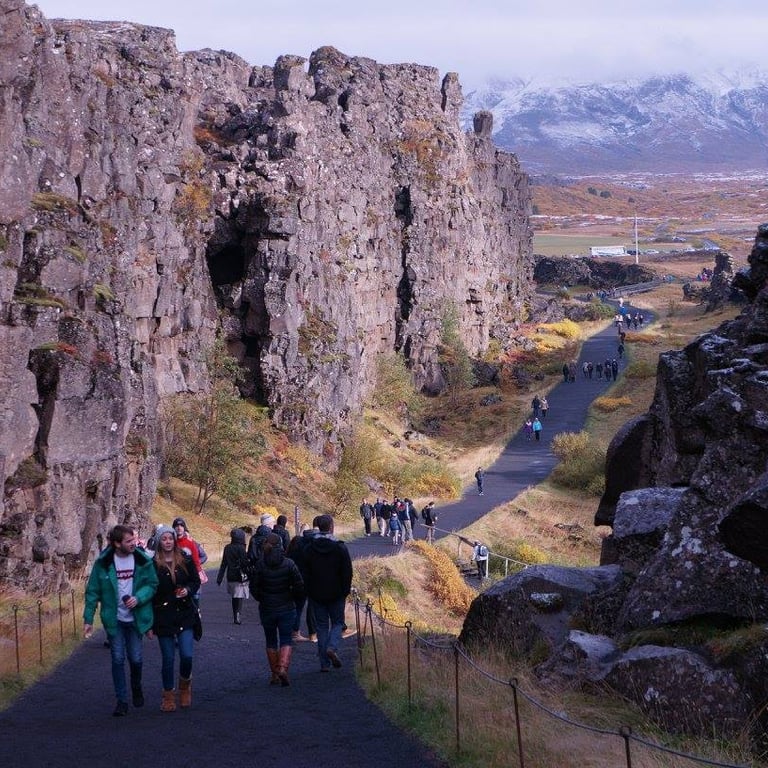
Thingvellir in summer and autumn
Geysir
The next stop is often Geysir, of which all the worlds geysers are named after. The old Geysir is very very quiet these days, but his little brother Strokkur is very active, erupting every 5-10 minutes or so. There are multiple hot springs in the area but only one typically erupts (Geysir erupts incredibly rarely). We go here almost every single time we're in Iceland because it's a fun thing to see.
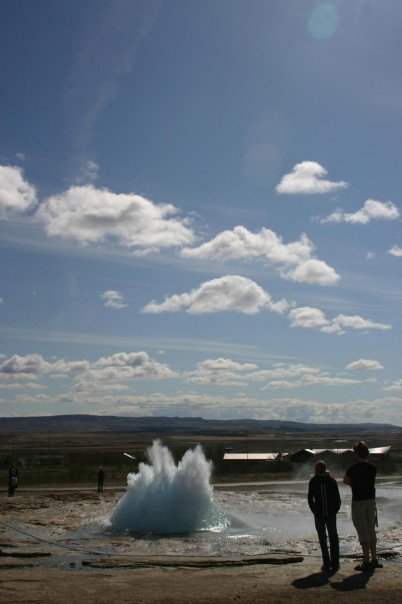

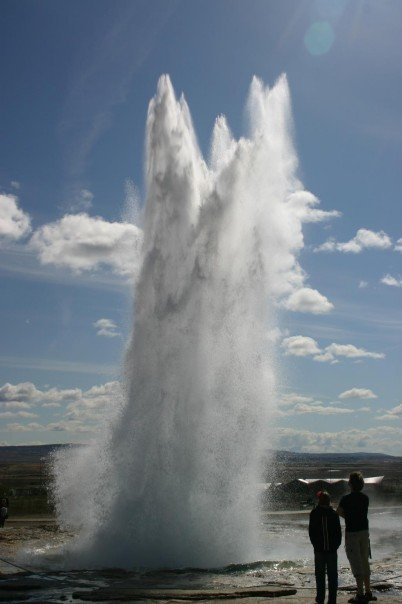

Strokkur Eruption. Photo taken many many years ago. The bowl around it has grown significantly since.
Gullfoss
The last of the primary stops along the Golden Circle is at Gullfoss. The tours sometimes switch the stops of Geysir and Gullfoss around as they're close to each other. Gullfoss is a waterfall of huge proportions, as is often with Icelandic waterfalls. What I always say to people is that there's pretty much no place on earth that can impress an Icelander with a waterfall because we have the absolutely most incredible array of massive waterfalls scattered all over the country. Waterfalls in Iceland are like castles in Scotland - they're everywhere! I think the only waterfalls, aside from those we have in Iceland, that I've found impressive were Iguazu Falls in Brazil/Argentina, Niagara Falls on the Canadian side and Angel Falls in Venezuela.
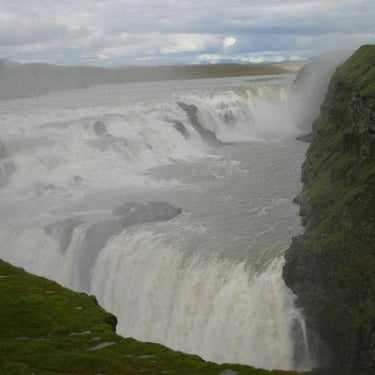
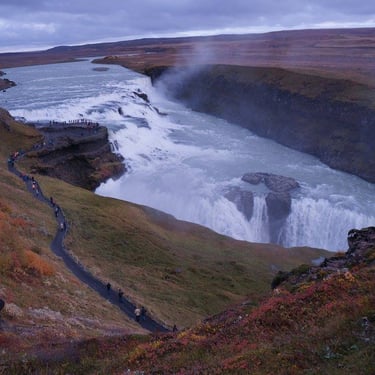
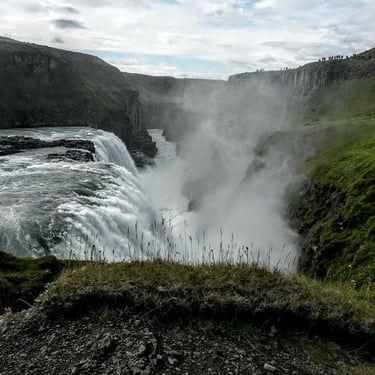
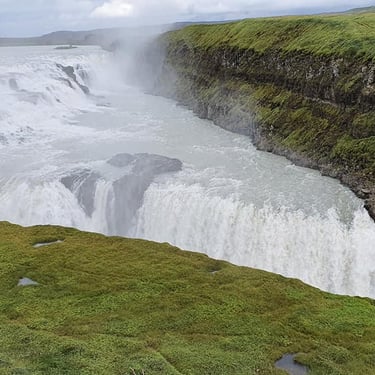
Photos taken at Gullfoss at different times of year
Gullfoss or "Golden Falls" are a tectonic waterfall which was almost destroyed by the Icelandic government as they wanted to create a hydroelectric dam there. Just as well they did not, because Iceland makes a lot more money from tourism coming here than they'd ever have done with a hydroelectric plant!
Aside from these three stops, where people stop varies between companies or personal choice if driving. Some of the other very popular stops include:
Fontana Spa visit + Geothermal bread experience in Laugarvatn
The Secret Lagoon visit
Kerið Crater
Day 3: The South Coast Tour
Aside from the Golden Circle tour, if you want to get a glimpse into what Iceland is like, the South Coast is a brilliant area to visit that is within daytrip range from Reykjavik. What's special about the South Coast is that it forms a vast plain of sediments which are then abruptly met by sheer cliffs and from the top of these cliffs there are waterfalls falling left right and centre. It's a spectacular sight, with the added bonus of several volcanoes and glaciers (Icelandic volcanoes are often hidden under glaciers!). The reason for this peculiar but stunning landscape is that these cliffs previously formed sea cliffs, so the sea was beating on the mountains for a very long time, leaving these vertical cliff faces in place. Now that the sea level is down, what forms the lowlands of the south is the former sea bed.
A tour of the South Coast would typically take you straight from Reykjavik to Seljalandsfoss waterfall. Some companies leave Seljalandsfoss until last because it is spectacular at sunset. Interestingly, I don't have any recent photos I could use of Seljalandsfoss because I have seen it more than countless times and so I stopped taking photos every time I stopped there. However, right next to Seljalandsfoss, hidden in the mountain just 5min walk along the cliff towards the north is a secret waterfall called Gljúfrabúi or "Canyon Dweller" and believe it or not, many people completely miss it when they're there, including myself! I had lived all my life in the South and never knew it was there until maybe in 2018 or so! And I told my sister, who is 8 years older than me, about it last year and she had no idea either and saw the waterfall for the first time ever just last year! It is a magical place where you walk into a crevice in the mountain and you walk into this cavern where a waterfall falls down into the cavern. It's stunning!
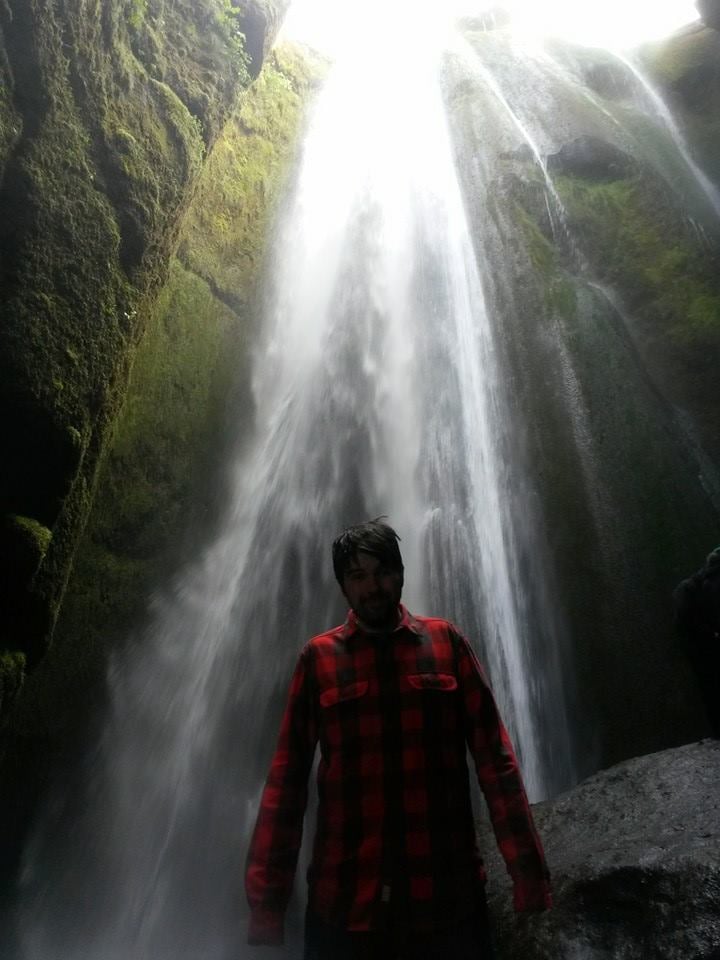

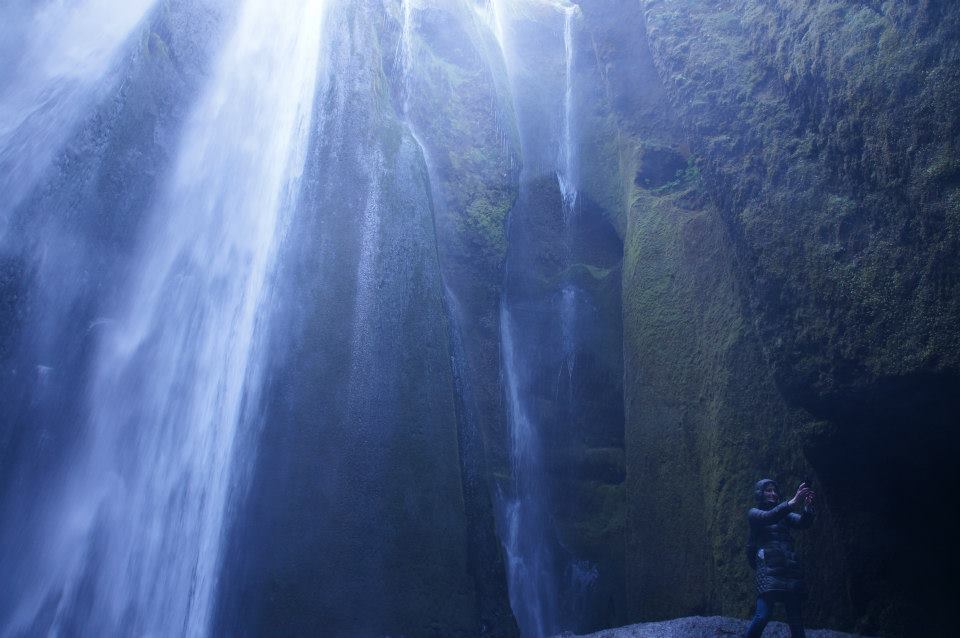

Gljúfrabúi (Or Canyon Dweller) near Seljalandsfoss
Another standard stop of the South Coast Tour will generally be to to go and see the spectacular Skógafoss waterfall.


Skógafoss waterfall on the South Coast tour in Iceland
After Skógafoss you'd typically be taken to see Sólheimajökull glacier, but for those of us who visit frequently it's a stark reminder that our glaciers are disappearing, and FAST.
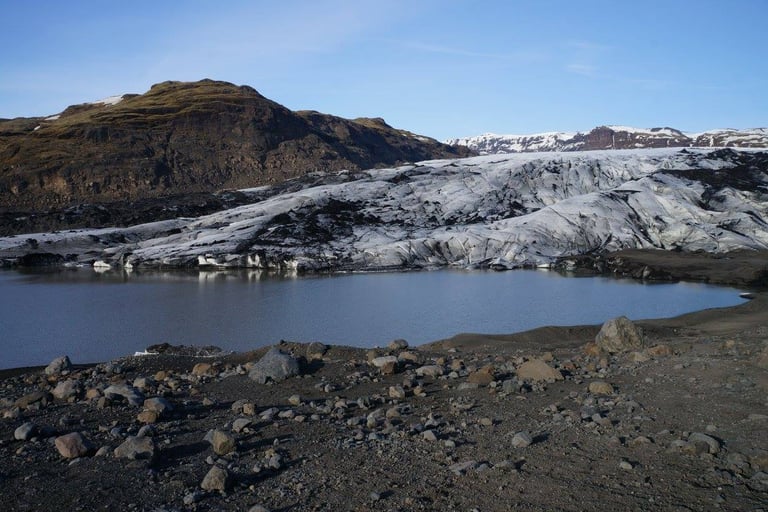

Sólheimajökull outlet glacier which is vanishing at an alarming rate
The furthest you'll go on the South Coast Tour is to the village of Vík and the stops your tour operator will make varies. In a small group tour there tend to be more stops, in the big bus tours, there tend to be less but as a minimum you'll stop at the village for lunch, where you can also explore the black sand beach and the seastacks. You'll also visit the beaches nearby Vík, which are stunning.
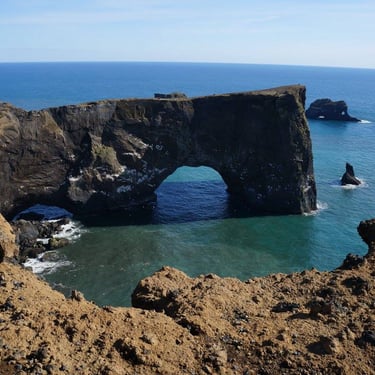
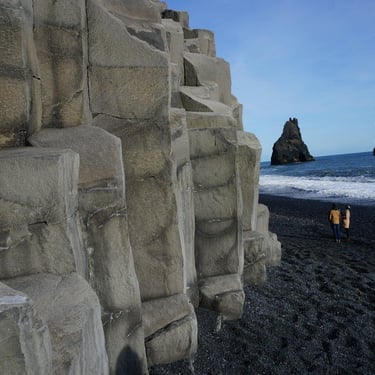
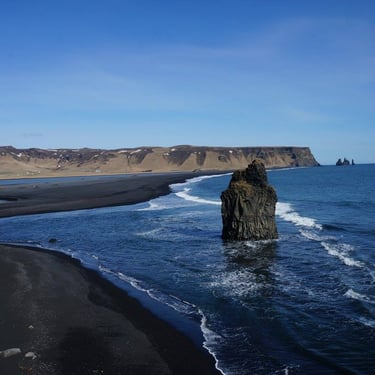
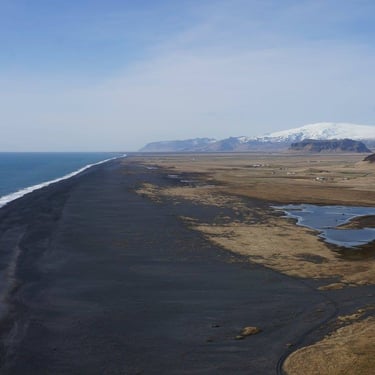
The beaches and cliffs of Vík
Day 4: Departure day (+ possible Blue Lagoon)
On your last day of your long weekend, it depends on what time your flight is whether you´ll have time do do anything or not. However, a very popular option for many people is to go to the Blue Lagoon in the morning if they have the time. This is however highly dependent on volcanic activity, as the last few volcanic eruptions have started eerily close to the Blue Lagoon. The lagoon however is not within the volcanic fissure swarm, so the likelihood of the eruptions to start underneath you while you're bathing is next to nil. However, the volcanic eruptions have lately started at very, very short notice, so you better be prepared for a quick exit, as lava flow can quickly close roads (in fact, going to the Blue Lagoon will require you to drive over a road that has been built on top of still-hot lava from recent eruptions). Just see for yourself in the below footage from one of the 2024 eruptions.

Video footage from a 2024 eruption near the Blue Lagoon in Iceland
I'd say it's definitely an experience, especially if you've never been there before, but certainly be very aware of the risk of going there. Alternatively, many if not most people I know who have been to the Sky Lagoon have said they absolutely loved it, so that might be a very good alternative instead of the Blue Lagoon. We haven't been yet but it is very much on our list to do, probably the next time we're in Iceland, as we've heard raving reviews left, right and centre.
Genuinely one of my favourite things about Iceland is the food. You hear all these scary stories of rotten shark, sour sheep testicle patés and the like (and yes, these exist), we don't actually tend to really eat those when in Iceland but just enjoy look at and laughing at tourists eating those things. Their faces are epic!
As an Icelander, my favourite food to eat in Iceland is all-things lamb. The Icelandic lamb is delicious. Most Icelandic lambs are born on farms but then taken to heaths, highlands or other type of wilderness for the rest of the summer and then gathered back to civilisation at the end of the summer. The wilderness isn't bountiful of food for them, so they need to put a bit of effort into feeding themselves, just like wild deer or other wild animals. They climb mountains, jump over streams and just generally get quite a lot of exercise in the wilderness which means that the Icelandic lamb isn't nearly as fatty as for example those in the UK that stand eating grass in fields all day long and barely move. So rest assured these animals have had as good of a "free range" life as any animal could ever have. My favourite lamb products include slow-cooked shoulder of lamb (like that in the restaurant Sæta Svínið), leg of lamb and saddle of lamb (though these cuts are really hard to get in a restaurant but rather just at a Sunday roast with the parents), lamb filet and lamb chops (these you CAN get at restaurants and are delicious). The hot dogs also contain lamb meat, as well as other mixture of meat. Lamb's liver is tasty too, as is the Icelandic equivalent of "Haggis" which contains liver, fat, spices, oats etc and called "Lyfrarpylsa" or "Liver sausage". There's also our take on blood sausage / black pudding called "Blóðmör". You get these at the supermarkets. Another absolute favourite of mines is the smoked lamb called "Hangikjöt" either as a big piece at a family dinner, or as a topping for bread.
Obviously fish is incredibly good and popular in Iceland but cod, haddock, salmon and trout is the most popular, all are delicious. I personally am a huge fan of trout. One of the most famous seafood you get in Iceland is the langoustine, either grilled, or as a seafood soup, both of which are absolutely incredible.
There's also plenty of delicious food to grab on the go, like hot dogs which, if you ask for one "with everything" contains finely chopped onion, crunchy onions, remoulade, Icelandic sweet mustard (it's not too sweet but delicious) and ketchup. There are also sandwiches sold in supermarkets and gas stations with sandwhich spread like shrimp salad (shrimp, eggs, mayo), tuna salad, smoked lamb and bean salad, roastbeef and more, all very tasty and reasonably priced if you buy them in the Bonus or Kronan supermarkets. Iceland also does incredible meat subs, the most famous place being Hlöllabátar on Ingólfstorg Sqare in the town centre.
Aside from food, Iceland also has incredible, INCREDIBLE cakes!!! Our baking traditions come from Danish pastry schools, so there's that! You should definitely head down to a bakery some time and try the delicious stuff there. Sweets are just great in general in Iceland. Many contain liquorice but it's a lot milder than those found in the Scandinavian mainland, and is often covered in chocolate. Just go to the Bonus supermarket and stock up with goodies as gifts for your family and friends at home!
Food to try while in Iceland
Gifts to take home from Iceland
By far the most popular presents we bring back from Iceland are the Icelandic sweets. They are very tasty and even liquorice-skeptics agree that they are pretty good! Below are some of our favourites, all of which you can buy fairly cheaply at the Bónus or Krónan supermarkets:
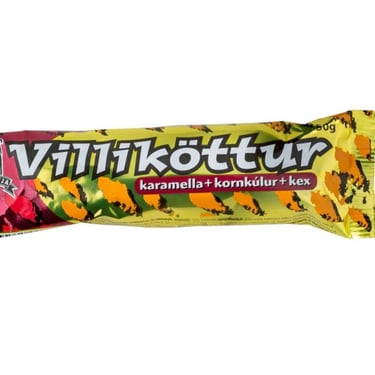
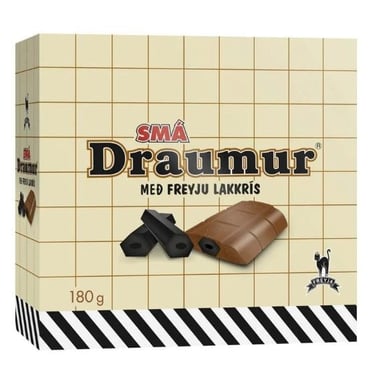
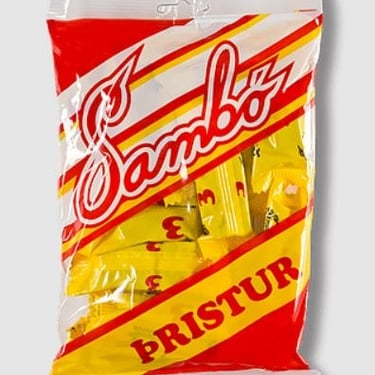
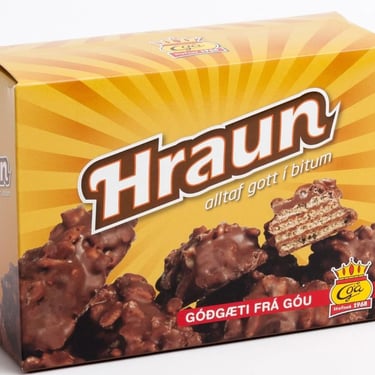
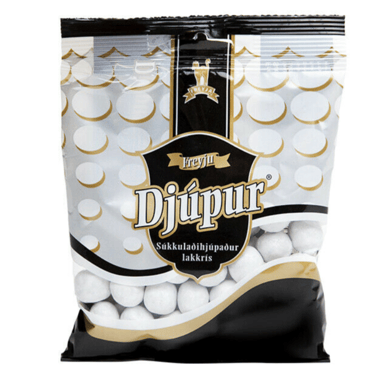
Another thing I almost always bring from home is the alcoholic drink "Opal". It is a vodka-based shot drink which has melted liquorice Opal tablets in them. It's thick, sticky and I always take a bottle along to parties back in the UK to let people try it. While everybody's completely disgusted with the first sip, they somehow can't stop drinking the stuff and usually by the end of the night they love the taste of it! You'll most likely be able to buy it cheaper in the Keflavik Duty Free as you land in Keflavik, but you can also buy it in the state-run Vinbudin shops.
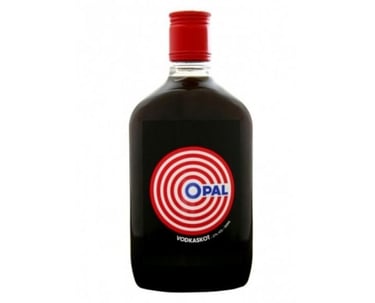

Places of interest for geologists within daytour reach of Reykjavik
Iceland is a geologist's heaven and literally a living laboratory. Iceland's geology is remarkably significant because it sits atop the Mid-Atlantic Ridge, where the North American and Eurasian tectonic plates are pulling apart. This makes it one of the few places on Earth where a mid-ocean ridge is visible above sea level and it is clearly visible in several places in Iceland, particularly in the Reykjanes Peninsula and Þingvellir National Park. The ongoing rifting and spreading between these plates cause frequent volcanic activity, shaping the island's dynamic landscape and providing a natural laboratory for studying plate tectonics and seafloor spreading in real time. This has been particularly noticable lately, with the frequent volcanic activity on the Reykjanes Peninsula in the last few years. The volcanism in Iceland is the reason for the presence of lava fields, geysers, hot springs, geothermal heat, calderas, craters, pseudocraters, cinder cones, scoria, hornitos Móberg mountain ridges, volcanic sandstone, lava tubes, ignimbrite, volcanic trap mountains consisting of numerous lava flows interbedded with red paleosol. I could go on and on.
Quite frankly, everywhere in Iceland is of geological importance or interest - geology is what makes the landscape and due to the presence of lots of ice, water and generally not great conditions for vegetation, rock outcrops abound! Many of the recommended tours below feature destinations very much of interest of geologists!
The Reykjanes Peninsula: Where the Mid-Atlantic Ridge is at its most active, with almost monthly volcanic eruptions taking place lately in the area surrounding the Blue Lagoon. Even if there's not an on-going eruption when you're there, there's still plenty to see, like lava that's still emitting heat, Móberg ridges created during the ice age when volcanism took place below an icecap, lava fields, craters, geothermal fields of Sigtún in the Krýsuvík area and Gunnuhver.
The South Coast: Surrounded by glaciers, which are underlain by volcanoes like Eyjafjallajökull and Katla, but also the famous volcano Hekla that is well and truly due an eruption, the South Coast is particularly stunning due to many cliffs that were formed at the base of volcanoes during a time when the sea level was higher, making them former sea cliffs that now are on dry land. The south is incredibly flat otherwise, forming a former sea bed, making driving along the Road 1 pretty easy. There is a lava cave within the mountain range that separates Reykjavik from the south called Raufarhólshellir, definitely worth a visit, as well as a former magma chamber you can descend into, a site called "Thrihnukagigur" (Þríhnúkagígur).
The Golden Circle: Depending on what tour you take or whether you're driving yourself, you can visit the Kerið Crater. All tours will take you to Þingvellir National Park, famous for the rifting activity that takes place there, clearly visible when you look at the vast lava field. The area also contains the famous Geysir area as well as Gullfoss, which is a peculiar but spectacular tectonic waterfall. On a clear day, you'll also get good views of Langjokull glacier and it's possible to do snow mobile tours from Gullfoss to the glacier.
I'm sure I'll add to this list in the future, but if you've just got a long weekend in Reykjavik, these three areas should keep you plenty busy with some spectacular geology!
Recommended daytours from Reykjavik
Do you have a bit longer time to explore Iceland than just a long weekend? Consider taking a look at my 9-10 day itinerary around the ring road here.
Did you find this content interesting or useful? Click to share on your socials:
Read about our other trips:
Follow us on Social Media for travel updates and top tips!
© 2025. All rights reserved.
Find out about super-cheap flights and flight sales as soon as they happen from your home airport. Try 30 days for £1 GBP with 14 day money-back guarantee and cancel any time.
Click here for more information.


